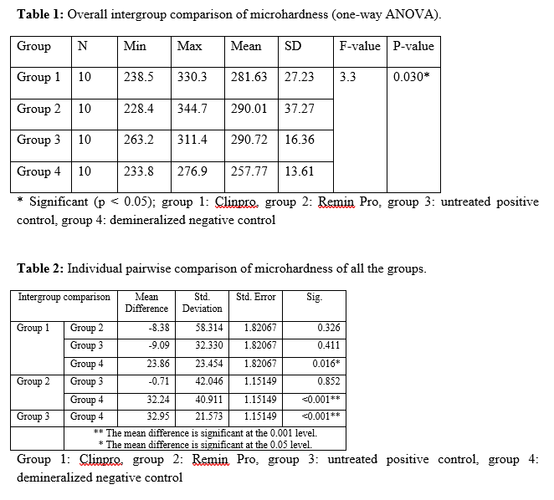-
Home
-
About JCTR
-
Gold Open Access
-
Issues
-
Editorial board
-
Author guidelines
-
Publication fees
-
Online first
-
Special issues
-
News
-
Publication ethics
-
Partners
-
Submit your manuscript
-
Submit your review report
-
Editorial Office
-

This work is licensed under a Creative Commons Attribution-NonCommercial 4.0 International License. ISSN print: 2382-6533 ISSN online: 2424-810X
Volume 6 Issue 3
Comparative evaluation of enamel microhardness after using two different remineralizing agents on artificially demineralized human enamel: an in vitro study
J. Sai Sahiti, Vamsee Krishna N, S. Datta Prasad, C. Sunil Kumar, S. Sunil Kumar, K.S. Chandra Babu
Sahiti et al. J Clin Transl Res 2020; 6(3):5
Published online: September 5, 2020
Abstract
Aim. The purpose of this study was to compare the remineralization outcomes of two agents using the Vickers microhardness test on artificially induced enamel subsurface lesions.
Materials and Methods. Forty sound extracted premolars were selected as samples for the current study and divided into four groups of 10 teeth each: Clinpro (group 1), Remin Pro (group 2), untreated positive control (group 3) and a demineralized negative control (group 4). All the sample groups were assessed first at baseline then after demineralization and remineralization using DIAGNOdent. After the remineralization process, Vickers microhardness test was performed on all sample groups to assess surface microhardness (SMH). The results obtained were then compared using one-way ANOVA for difference in SMH.
Results. Vickers microhardness number values were analyzed using one-way ANOVA and samples in the experimental groups 1 and 2 showed a statistically significant difference compared to the control groups (p < 0.05). Remineralization was higher in the Remin Pro group followed by Clinpro group.
Conclusions. The results of this in vitro study show that both Remin Pro and Clinpro are equally effective as remineralizing agents. Although Remin Pro tended to yield a higher microhardness, no significant differences were observed between the two agents.
Relevance for patients. Enamel mineral loss leads to the degradation of the surface and subsurface structures of teeth. Natural remineralization that occurs physiologically is not sufficient to overcome the hurdles of mineral loss, a tooth undergoes due to changes in food habits and life style. A thought on remineralization and management such as prescribing remineralising agents and regular professional topical fluoride applications would definitely render satisfactory results by a strong healthy enamel.

DOI: http://dx.doi.org/10.18053/jctres.06.202003.005
Author affiliation
Department of Conservative dentistry and Endodontics, CKS.Theja Institute of dental sciences and Research ,Tirupathi, Andhra Pradesh.
*Corresponding author
J. Sai Sahiti
Department of Conservative Dentistry and Endodontics, CKS Theja institute of Dental Sciences and Research, Tirupati-517501, Chittoor District, Andhra Pradesh, India.
Tel: +91 8197896757
E-mail: dr.sahithijaladi@gmail.com
Handling editor:
Michal Heger
Department of Pharmaceutics, Utrecht University, the Netherlands
Department of Pharmaceutics, Jiaxing University Medical College, Zhejiang, China

